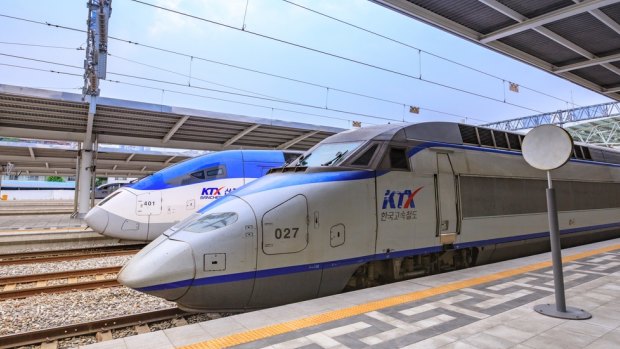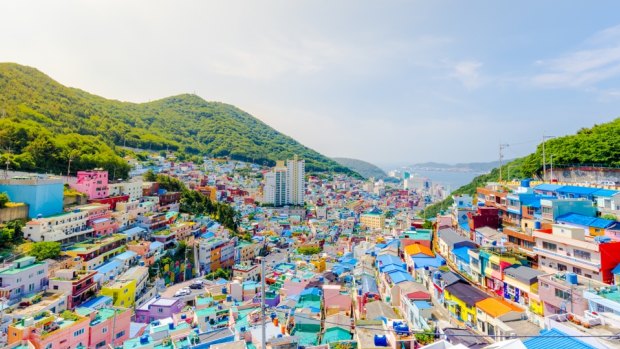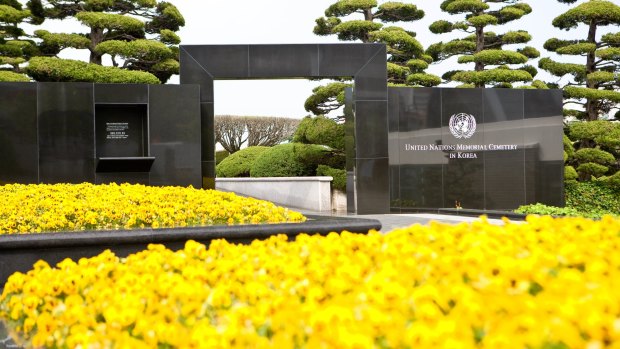This was published 5 years ago
South Korea KTX trains: On board the 305 km/h train from Seoul to Busan
By Tim Richards

South Korea's high-speed bullet trains (KTX) and Korail trains at the Seoul station.Credit: Shutterstock
As I enter Seoul Station, I have half an eye out for zombies.
A week before flying to the South Korean capital I watched Train to Busan, the excellent 2016 movie about a train journey overtaken by a plague of the undead.
It managed to both evoke horror, and depict Korail's high-speed rail network in a good light. In the midst of the action the rail company's staff were unfailingly cool under pressure (except when turned into zombies themselves, of course).

Gamcheon Culture Village. Despite the formal-sounding name, this place is a riot of colour and art. Credit: SHUTTERSTOCK
But there are no members of the undead community here today, just passengers milling around the slick station interior. As is often the way in Seoul, the new has trumped the old – the elegant old station next door was retired from service when the country's impressive high-speed rail network, known as KTX, was launched in 2004.
The new station is more like an airport than anything, all glass and steel with a lofty curved roof letting in natural light. Its shiny white interior is packed with shops, and big screens advertising products endorsed by K-Pop boy bands.
It's a fittingly futuristic prelude to my trip aboard KTX 121 to Busan, though I'll be breaking the journey in the historic city of Gyeongju.

The United Nations Memorial Cemetery in Busan, South Korea, is is an unusually tranquil and contemplative place.Credit: Korea Tourism Organisation
I'll be travelling aboard a KTX train that's engineered to reach 305km/h, a remarkable velocity that would devour the Sydney to Melbourne distance in less than three hours (we can only dream). For Koreans, it's meant the rail trip between the capital and the busy port of Busan has been cut from more than four hours by conventional train, to not much more than two hours today.
That speedy trip is also easily accessible to travellers. All railway signage is in Korean and English, tickets can be bought online, and a Korail Pass is available for multiple journeys over two to five days.
Glancing at the departure board I can see details of the next six scheduled trains, the last an intriguingly labelled "DMZ train" to Yeoncheon near the North Korean border. I'm heading south, however, and the "Delay" column to the right presents a pleasing string of zeroes.
We're not told the platform number of each train until 15 minutes before departure, I discover, which adds a certain tension as the clock ticks toward 10am. But it's easy enough to find platform 12 when I need to, and it's aided by the fact there are no ticket gates; only a yellow strip indicates the point beyond which you must possess one.
The tapered bullet nose of my KTX train is unmistakeable, and in first class the seats are laid out in a spacious 1-2 configuration. I'm in a single on the left, with plenty of leg room and seat width. The drop-down tray includes a small rung against which to prop a tablet, and the seat is upholstered in a rich red shade.
Quite posh all round, though ergonomically it feels slightly out for someone of my height: the tray and armrests are too low, and the fixed curve of the seat isn't quite right for my back.
Then we pull out on the two-hour journey to Gyeongju, crossing the Han River to the Gangnam side of the city, picking up speed as we head south. An attendant delivers a KTX welcome pack of a cookie, nuts and refresher towel, while on the screen above a series of animated animals explains the safety features of the train.
There's nothing like a cute anime character demonstrating how to break a window in the event of an emergency, to remind me of that zombie film I'd almost forgotten. But they do it in a charmingly reassuring way.
Half an hour into the journey, the screen tells me we're travelling at 275km/h. It's such a smooth ride that I have no sense of the speed, but there's no question that we're zipping down the Korean Peninsula at an extraordinary pace.
My fellow passengers are snoozing or engaged with electronic devices, as I glance at the passing scenery. It's mostly lush green farming country framed by rolling green hills, occasionally punctuated by substantial apartment blocks. I also spot a lot of greenhouses, unsurprising in a country with hot humid summers but very cold winters.
In the vestibule between carriages there's a little oasis of calm: a free vending machine dispensing bottles of water, along with a small library area stocked with magazines and newspapers.
Then, before I've fully adjusted to this brave new world of fast-moving metal, we arrive at Singyeongju (literally "New Gyeongju"). It's the high-speed station serving Gyeongju, placed at a distance outside the city so as not to disturb its heritage sites.
They are impressive. By the 7th century, the Silla Kingdom ruled the entire Korean Peninsula from here, and left behind many reminders of its wealth. The most visually arresting are found at Tumuli Park, a stretch of manicured parkland featuring enormous burial mounds.
These largely survived looting over the centuries, and were excavated a few decades ago to reveal a treasure trove. A single mound containing the remains of a king and queen produced 68,000 other items, including a golden crown. They were also accompanied, more grimly, by the remains of a favoured servant girl, destined to follow them to the afterlife.
One of the smaller tombs is open for view, and I wander inside past the burial place and replicas of the artefacts discovered there, including a famous painting of a flying horse.
Gyeongju is packed with similar sites of interest, I discover over the next 24 hours, though it's largely overlooked by international tourists – I could count the other Westerners I spot on the fingers of one hand. Koreans, however, flock here to learn about their history. A tourism zone of hotels and amusements is neatly separated from the old city and its heritage sights.
These include the World Heritage-listed Bulguksa Temple, founded in AD 751 and restored many times since. It's South Korea's most significant Buddhist place of worship and a beautiful piece of architecture with stone stairways and decorated wooden eaves.
The Gyeongju National Museum houses the treasures excavated from the Silla burial mounds; and outside the city is Yangdong, a working village of traditional architecture that welcomes visitors.
I've seen a lot in a day, but I still have to reach Busan. Back at Singyeongju Station – another soaring structure of glass and steel – I'm catching the 16.37 KTX train south. It's running late by a scandalous six minutes; but as it'll deliver me to the port city in a mere 35 minutes, the delay isn't worth worrying about.
Busan proves to have the characteristic energy and colour of port cities. Though its industrial operations take up a big chunk of its coastline, there are also plenty of sights worth a visit.
One of my favourites is Gamcheon Culture Village. Despite the formal-sounding name, this place is a riot of colour and art. Established in the wake of the Korean War as a home for refugees, this settlement of small houses is spread across slopes in Busan's west.
Gamcheon is still a neighbourhood where people live and work, but it's also been adopted by artists, who've established galleries and decorated its streets. With the houses painted bright colours, and narrow walkways leading to unexpected artworks, Gamcheon is like one big art installation itself.
My final stop in Busan is the opposite in terms of mood, but similarly uplifting. The United Nations Memorial Cemetery was founded as a final resting place for international solders who died in the Korean War of 1950-53, defending the country from the North Korean invasion.
South Korea remembers that assistance with great respect. The cemetery is a serene, moving place that combines aesthetic appeal with solemn remembrance of the war dead, including Australian soldiers.
One of them, James Daunt, was a mere 17 years old when he died, and is remembered by the Daunt Waterway that runs through the site's heart. On either side are carefully maintained gardens, with graves and monuments from nations as diverse as Turkey and Canada. A curving Wall of Remembrance is inscribed with the names of all who fell.
For such a busy, noisy city as Busan, this is an unusually tranquil and contemplative place. It's worth visiting for both its physical beauty and its reminders of Korea's turbulent past.
TRIP NOTES
FLY & TRAIN
Asiana flies daily between Sydney and Seoul, with codeshare connections via Qantas. See asiana.com
The Seoul-Busan KTX fare ranges from $75 (economy class) to $100 (first class) one-way. The Korail Pass starts at $150 for two days of travel, up to $260 for five days. See letskorail.com
STAY
Four Seasons Hotel, fourseasons.com/seoul. Luxurious, stylish accommodation in central Seoul. From $450 per night.
Hyundai Gyeongju, hyundaihotel.com/gyeongju. Big tourist-friendly hotel with lake views. From $120 per night.
Novotel Ambassador Busan, accorhotels.com. In the lively entertainment zone next to Haeundae Beach. From $125 per night.
MORE
Tim Richards travelled courtesy of the Korea Tourism Organisation.
See also: The world's greatest train journeys
See also: More than 50 years on, Japan's bullet trains are still ahead of their time
Sign up for the Traveller Deals newsletter
Get exclusive travel deals delivered straight to your inbox. Sign up now.